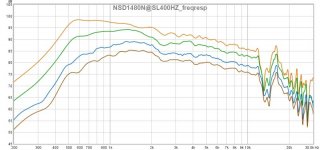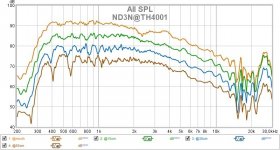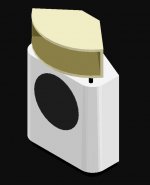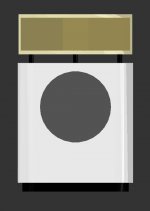Somewhere lost within those seemingly highly detailed and specific dictates is the fact that rooms vary. Which means that dispersion and total sound varies which means, in contradiction to PeterBracke, that your favourite horn shape varies. Unless PeterBracke is able to produce a Standard Room out of a magician's hat like a rabbit.
As I mentioned earlier, that kind of slave-to-geometry is going out of fashion as robust ambience comes into favour. Or maybe it is the battle between unsatisfying precision speakers and sloppy musical speakers.
Having said that, everybody should have a look at Toole's 3rd edition and how his Spinorama measurements relate to human observer ratings. (OK, panel speaker enthusiasts should not look at it.)
B.
As I mentioned earlier, that kind of slave-to-geometry is going out of fashion as robust ambience comes into favour. Or maybe it is the battle between unsatisfying precision speakers and sloppy musical speakers.
Having said that, everybody should have a look at Toole's 3rd edition and how his Spinorama measurements relate to human observer ratings. (OK, panel speaker enthusiasts should not look at it.)
B.
Last edited:
I agree with everything, except maybe not "including all reverberations." This sounds like putting too much weight into the reverberation field. The ear can filter out the reverberation better and better as the frequency goes up and so depending on the DI the room reverberation gets basically ignored and the direct field becomes the dominate perception attribute. But agreed - the reverberant measurements shouldn't be too far off the direct field ones - just not equal in perception to the direct field. A constant DI system would be a minimum requirement, but not necessarily sufficient.The direct response of the speaker should be flat on the listening axis (with a 15° toe-in, thus at 15°), but the total response (including all reverberations) should be flat from 160 Hz to 1 kHz and then drop above 2.5 kHz at a rate of -1 to -2.5 dB/octave. The corner frequency can be anywhere between 1 and 2.5 kHz and a linear fit of the drop-off of the total response should result in a -6 to -10 dB crossing at 20 kHz. The majority of loudspeakers that sound neutral fulfill this requirement (LS3/5, LS50, Revel ...).
This should also address Ben's comment. The room becomes every more audible and a factor as the di goes down - more and more indirect energy. A high DI loudspeaker can take the room out of the picture except at VLFs where everything depends on the room.
This! Absolutely 100% true.The abrupt change in profile creates diffraction. The purpose of this is to get a wide coverage angle at high frequencies. A constant coverage angle is a requirement in sound reinforcement applications.
For home or studio applications this is not the case. The direct response of the speaker should be flat on the listening axis (with a 15° toe-in, thus at 15°), but the total response (including all reverberations) should be flat from 160 Hz to 1 kHz and then drop above 2.5 kHz at a rate of -1 to -2.5 dB/octave. The corner frequency can be anywhere between 1 and 2.5 kHz and a linear fit of the drop-off of the total response should result in a -6 to -10 dB crossing at 20 kHz. The majority of loudspeakers that sound neutral fulfill this requirement (LS3/5, LS50, Revel ...).
This is achieved in a standard sized living room when a horn is used with a hypex expansion rate (T: 0.5 - 1, includes elliptic expansion rate) and an expansion rate cut-off of 350 - 450 Hz. The AH-425 fulfills these requirements. I would not consider the Azurahorn expensive (without shipping costs), but in Europe alternatives such as the JMLC-400 or a Jabo KH-53 A can be bought at a lower cost.
For a non-axisymmetric horn that has a larger width than height, a lower expansion rate cut-off should be chosen: e.g. 300 Hz for the Iwata type.
Most sound reinforcements horns will sound colored when used in a normal room (vs. in a large venue). But the Faital Pro LTH-142 might be worth a try.
One thing that could be done with constant directivity horns is to add room absorption because what you hear is the horn di plus the room absorption. I do agree though that it can be difficult to achieve the right tonal balance when the power response is flat.
@PeterBracke Thank you. I have been enjoying your explanations since many, many pages ago on this thread although I am only up to page 593, I am pleased to be learning from you backwards and forwards.
Are we trying to have a drop of 1 db per octave above 1k in total power roughly since we will have progressively higher directivity from the horn such that the listener will perceive a flat power response as the roll off in total power is compensated by directivity?
Am I correct to notice that the Le Cleach horn as iterated on the exponential or other T value profile expansion in the range you mention, doing this job of increasing directivity to compensate for total power roll off? Is this roll off somewhat inherent in CD’s?
And, does this also eliminate the requirement for in band equalization for the horn? I’ve seen this requirement mentioned by some people.
Regards,
Jamie
Are we trying to have a drop of 1 db per octave above 1k in total power roughly since we will have progressively higher directivity from the horn such that the listener will perceive a flat power response as the roll off in total power is compensated by directivity?
Am I correct to notice that the Le Cleach horn as iterated on the exponential or other T value profile expansion in the range you mention, doing this job of increasing directivity to compensate for total power roll off? Is this roll off somewhat inherent in CD’s?
And, does this also eliminate the requirement for in band equalization for the horn? I’ve seen this requirement mentioned by some people.
Regards,
Jamie
@gedlee Dr. Geddes, would you be so kind as to define DI and constant directivity? I am trying to understand these references as total power versus power density or perceived power as frequency dependent or not. I don’t quite have it, but sometimes I am curious whether participants are comparing the same measures, or I just don’t have a clue.
Regards,
Jamie
Regards,
Jamie
Just a note to anyone interested ...
Lynn has a spare pair of AH 425s which as many of you know, were designed for the Beyond the Ariel project. He only needs one pair.
Martin drilled this pair for 3-bolt mount 288s, although (of course) additional holes can be added. The mounting flange is quite robust.
I'll be picking the horns up from him in a couple of days, and at that point, I'll shoot some pictures, and put a for sale post up in the Marketplace sub-forum as well as listing it on my Galibier "Specials" page.
Shipping will be limited to CONUS, so @bentoronto need not apply ;-)
... Thom
Lynn has a spare pair of AH 425s which as many of you know, were designed for the Beyond the Ariel project. He only needs one pair.
Martin drilled this pair for 3-bolt mount 288s, although (of course) additional holes can be added. The mounting flange is quite robust.
I'll be picking the horns up from him in a couple of days, and at that point, I'll shoot some pictures, and put a for sale post up in the Marketplace sub-forum as well as listing it on my Galibier "Specials" page.
Shipping will be limited to CONUS, so @bentoronto need not apply ;-)
... Thom
Hi folks, Thom just told me this thread is still going on! I'm amazed!
Thom and I are building a minor variation of Gary Dahl's system, cabinet a little different, but not much. The 18Sound 1480A or 1480N (titanium nitride) are the likely candidates for the HF driver. The beryllium drivers are appealing but are also astronomically expensive.
I've been reading with great enjoyment Bjorn Kolbrek's new book, "High Quality Horn Loudspeaker Systems", available at Parts Express at the daunting price of $150. Aside from the price, it's large and heavy enough you have to put it on a pillow on your lap or your hands get tired after ten minutes. But I love books, and this is certainly a keeper. Half the book is a historical review, and the second half is a deep dive into theory (it is not a cookbook). It's a great read.
I would like to thank Peter Bracke for his excellent guidelines on target response contours, with particular emphasis on smoothness within the desired target response shape. 95% of the high-end speakers on the market fail to meet these basic requirements, which is regrettable.
As for the current versions of the Raven preamp and the 2nd version of the Karna power amp, I've been posting them on my Facebook page. It's a collaboration with Don Sachs in B.C., Canada, and I post a photo of the new power amps, as well as a short description of the overall topology.
Thom and I are building a minor variation of Gary Dahl's system, cabinet a little different, but not much. The 18Sound 1480A or 1480N (titanium nitride) are the likely candidates for the HF driver. The beryllium drivers are appealing but are also astronomically expensive.
I've been reading with great enjoyment Bjorn Kolbrek's new book, "High Quality Horn Loudspeaker Systems", available at Parts Express at the daunting price of $150. Aside from the price, it's large and heavy enough you have to put it on a pillow on your lap or your hands get tired after ten minutes. But I love books, and this is certainly a keeper. Half the book is a historical review, and the second half is a deep dive into theory (it is not a cookbook). It's a great read.
I would like to thank Peter Bracke for his excellent guidelines on target response contours, with particular emphasis on smoothness within the desired target response shape. 95% of the high-end speakers on the market fail to meet these basic requirements, which is regrettable.
As for the current versions of the Raven preamp and the 2nd version of the Karna power amp, I've been posting them on my Facebook page. It's a collaboration with Don Sachs in B.C., Canada, and I post a photo of the new power amps, as well as a short description of the overall topology.
Last edited:
Hi,
I intend to sell my TAD TD-4001 after trying the JBL 2451 with Radian Be diaphragms. I run them in ejmlc300 horns and they have an almost electrostatic smoothness but with dynamics to spare! It is not cheap but very reasonable. A pair of used 2451 can be had for under 200USD so the total will set you back less than 2k. It will get you a 1.5" exit driver that is hard to beat.
//Anders
I intend to sell my TAD TD-4001 after trying the JBL 2451 with Radian Be diaphragms. I run them in ejmlc300 horns and they have an almost electrostatic smoothness but with dynamics to spare! It is not cheap but very reasonable. A pair of used 2451 can be had for under 200USD so the total will set you back less than 2k. It will get you a 1.5" exit driver that is hard to beat.
//Anders
HI Lynn, good to read that you are well and still reply here.Hi folks, Thom just told me this thread is still going on! I'm amazed!
Thom and I are building a minor variation of Gary Dahl's system, cabinet a little different, but not much. The 18Sound 1480A or 1480N (titanium nitride) are the likely candidates for the HF driver. The beryllium drivers are appealing but are also astronomically expensive.
...
Maybe you remember the results I posted some years ago in a small circle. The 18s 1480A/N drivers seem to be very nice but they all have a deep hole above 12k. The following results are on a comparable round horn SL400HZ:

These drivers are an older design and there might be issues with the phase plug. The data on their web page does not show the truth about this driver.
What I recommend is to use The ND3 series, especially the ND3N or ND3SN drivers. Of course, there is Be version which is expensive but diaphragms are exchangeable to each other so there is an upgrade option.
Thanks for the info on the compression drivers! So ... the 18Sound ND3N, ND3SN, or (used) JBL 2451 with a new Radian beryllium diaphragm. I have a pair of 4-bolt AH425 Azurahorns (what Gary Dahl is using) as well as a pair of Athos Audio Yuichi A290 with 2"/5 cm depth machined aluminum adapters, and both Azura and Yuichi horns fit a compression driver with a 1.4" exit.
I want to keep EQ to a minimum, but with any luck, it looks like a shelf filter is going to be all that's needed. It should be interesting to compare the two horns.
The 3.9 cubic foot/110 liter (closed box) bass cabinet for the GPA 416 is shown below, with 4" radii on the left and right edges. This is a minor variant of Gary Dahl's 3.5 cubic foot boxes for his GPA 416's.
I want to keep EQ to a minimum, but with any luck, it looks like a shelf filter is going to be all that's needed. It should be interesting to compare the two horns.
The 3.9 cubic foot/110 liter (closed box) bass cabinet for the GPA 416 is shown below, with 4" radii on the left and right edges. This is a minor variant of Gary Dahl's 3.5 cubic foot boxes for his GPA 416's.
Attachments
Last edited:
The Yuichi is quite similar to TH4001 for which I have measurements together with ND3N already posted here:
https://www.diyaudio.com/community/...horns-measurements.395046/page-3#post-7253528
But I will attach them here again:

The setup was with a non-optimized adapter so that HF might even be better.
https://www.diyaudio.com/community/...horns-measurements.395046/page-3#post-7253528
But I will attach them here again:

The setup was with a non-optimized adapter so that HF might even be better.
Last edited:
How narrow the dip is depends on the Horn's geometry (along with a great many other things as well).Maybe you remember the results I posted some years ago in a small circle. The 18s 1480A/N drivers seem to be very nice but they all have a deep hole above 12k. The following results are on a comparable round horn SL400HZ:
View attachment 1141798
These drivers are an older design and there might be issues with the phase plug. The data on their web page does not show the truth about this driver.
Note Paul's measurements on the XT1464 horn's from 18Sound:
https://www.htguide.com/forum/forum/mission-possible-diy/34994-the-raptor-a-10-mtm#post631116
(..also note what he is saying relative to other waveguides.)
You also need to assess just how important a narrow-band dip is in the top octave (if it occurs for the desired horn), especially if you use a super-tweeter. Then contrast this with how linear it is on the particular horn and how linear the Impedance is (particularly with regard to compensation filters and achieving a lower part-count crossover).
Well, I know what the TAD TH4001 wood horn sounds like ... my Audionics friend Bob Sickler had the full TAD rig at home, and the folks I visited at the 2004 ETF were using the same horn. Very impressive, one of the few peers to the AH425. And it looks marvelous, which has to count for something.
As you can see from the drawing, the 3.9 cubic foot/110 liter bass enclosure is intended as a visual complement to either horn. An alternate vented cabinet would be the same width, 26 inches, but the depth and height would increase to accommodate a 7 cubic foot/200 liter cabinet. Bigger and more visually dominant.
Thom reported from his visit to Gary Dahl that the closed-box 416 didn't really need a subwoofer, so I did some sims, and sure enough, no problem when you account for room lift effects. Although the extra half-octave of a vented cabinet is welcome, the additional excursion below 30 Hz is not, particularly considering the 416 has an underhung voice coil and is not designed for long excursions (unlike a JBL 2235). And I already have a REL subwoofer for the home theater system.
As you can see from the drawing, the 3.9 cubic foot/110 liter bass enclosure is intended as a visual complement to either horn. An alternate vented cabinet would be the same width, 26 inches, but the depth and height would increase to accommodate a 7 cubic foot/200 liter cabinet. Bigger and more visually dominant.
Thom reported from his visit to Gary Dahl that the closed-box 416 didn't really need a subwoofer, so I did some sims, and sure enough, no problem when you account for room lift effects. Although the extra half-octave of a vented cabinet is welcome, the additional excursion below 30 Hz is not, particularly considering the 416 has an underhung voice coil and is not designed for long excursions (unlike a JBL 2235). And I already have a REL subwoofer for the home theater system.
Attachments
Last edited:
Yeah, you are right, the importance of the HF dip is a matter of debate. Although I would not call it narrow and my measurements were taken with a reference microphone Earthworks M23 which is excellent in a region where other mics yield more or less questionable results.How narrow the dip is depends on the Horn's geometry (along with a great many other things as well).
Note Paul's measurements on the XT1464 horn's from 18Sound:
https://www.htguide.com/forum/forum/mission-possible-diy/34994-the-raptor-a-10-mtm#post631116
(..also note what he is saying relative to other waveguides.)
You also need to assess just how important a narrow-band dip is in the top octave (if it occurs for the desired horn), especially if you use a super-tweeter. Then contrast this with how linear it is on the particular horn and how linear the Impedance is (particularly with regard to compensation filters and achieving a lower part-count crossover).
Hi,Well, I know what the TAD TH4001 wood horn sounds like ... my Audionics friend Bob Sickler had the full TAD rig at home, and the folks I visited at the 2004 ETF were using the same horn. Very impressive, one of the few peers to the AH425. And it looks marvelous, which has to count for something.
As you can see from the drawing, the 3.9 cubic foot/110 liter bass enclosure is intended as a visual complement to either horn. An alternate vented cabinet would be the same width, 26 inches, but the depth and height would increase to accommodate a 7 cubic foot/200 liter cabinet. Bigger and more visually dominant.
Thom reported from his visit to Gary Dahl that the closed-box 416 didn't really need a subwoofer, so I did some sims, and sure enough, no problem when you account for room lift effects. Although the extra half-octave of a vented cabinet is welcome, the additional excursion below 30 Hz is not, particularly considering the 416 has an underhung voice coil and is not designed for long excursions (unlike a JBL 2235). And I already have a REL subwoofer for the home theater system.
my own measurements of a similar (IMHO even better, in some ways) radial hypex horn, the Yuichi Arai A-320FL, with the JBL 2450J + Truextent Be diaphragm:
https://www.diyaudio.com/community/threads/jmlc-and-yuichi-horns-measurements.395046/post-7262359
I would HIGHLY recommend this driver+dia (the 2" exit version) to mate with the Yuichi or TAD horns, which were all designed for the TD-4001 driver, which in turn has the exact same internal geometry as the JBL 2450.
Any other driver-horn mix-and-match is a bit of a compromise, and specifically often gives up something in the lowest octave. Also, the 4" Truextent Be dia's are really clean all the way up to 20kHz.
Marco
Hi Marco,Hi,
my own measurements of a similar (IMHO even better, in some ways) radial hypex horn, the Yuichi Arai A-320FL, with the JBL 2450J + Truextent Be diaphragm:
https://www.diyaudio.com/community/threads/jmlc-and-yuichi-horns-measurements.395046/post-7262359
I would HIGHLY recommend this driver+dia (the 2" exit version) to mate with the Yuichi or TAD horns, which were all designed for the TD-4001 driver, which in turn has the exact same internal geometry as the JBL 2450.
Any other driver-horn mix-and-match is a bit of a compromise, and specifically often gives up something in the lowest octave. Also, the 4" Truextent Be dia's are really clean all the way up to 20kHz.
Marco
I can confirm your comments so far as the Yuichi A-290 is concerned. I am running a pair with Radian NEO950PB-16 and have to equalize out a rather pronounced notch at 1kHz. (I do this by squashing the peaks either side of the notch, on the right is diaphragm mass resonance, not sure what the cause is to the LF side of the notch.)
Most modern drivers and this horn are not the best match in my very limited experience. This measurement is 300Hz - 20kHz without any EQ, system is active and the driver has a dedicated amplifier channel.
I use a heavily modified DCX to equalize the horn.
@Lynn Olson, what is the depth of your adaptors -25mm? Yuichi also mentions the JBL 2441 as a suitable driver. I guess the modern equivalents would be 2450 series drivers as Marco remarked..
Is anyone aware of a modern and available driver that would do this horn justice in addition to the 2450?
With EQ the performance is quite good, and these are certainly the best sounding horns I have owned to date. (And likely the last)
Not sure exactly what you mean by diaphragm alignment. Can you explain? The drivers were purchased new from Radian, had measurements provided and on other horns like 2380A do not exhibit that notch.
Something to note is that the response is virtually identical on both channels so unlikely to be a driver defect. (Incompatible is more likely??) Distortion, group delay, and impulse response all look good.
The geometry is different from the TAD TD-4001 based on my reading, and that is definitely the case with the JBL 2440 drivers I have. (I also have OEM 2441 diaphragms which I could swap.) The Radian is much shallower, short path length and exit angle is 21° which might also be an issue higher up.
Something to note is that the response is virtually identical on both channels so unlikely to be a driver defect. (Incompatible is more likely??) Distortion, group delay, and impulse response all look good.
The geometry is different from the TAD TD-4001 based on my reading, and that is definitely the case with the JBL 2440 drivers I have. (I also have OEM 2441 diaphragms which I could swap.) The Radian is much shallower, short path length and exit angle is 21° which might also be an issue higher up.
- Home
- Loudspeakers
- Multi-Way
- Beyond the Ariel

